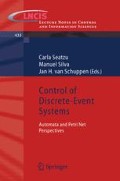Abstract
In previous chapters, Place/Transition nets have been used to model Discrete Event Systems with the aim of analyzing logical properties. However, such a model is not suitable for performance analysis because it does not keep into account the duration of the activities occurring in a system. Several extensions have been presented in the literature to address this issue, enriching the basic P/T net model with different temporal metrics and semantics. In this chapter we discuss the most common and significant ones.
Access this chapter
Tax calculation will be finalised at checkout
Purchases are for personal use only
Preview
Unable to display preview. Download preview PDF.
References
Ajmone Marsan, M.: Stochastic Petri Nets: an Elementary Introduction. In: Rozenberg, G. (ed.) APN 1989. LNCS, vol. 424. Springer, Heidelberg (1990)
Baccelli, F., Cohen, G., Olsder, G.J., Quadrat, J.P.: Synchronization and linearity. Wiley (1992)
Bérard, B., Cassez, F., Haddad, S., Lime, D., Roux, O.H.: Comparison of Different Semantics for Time Petri Nets. In: Peled, D.A., Tsay, Y.-K. (eds.) ATVA 2005. LNCS, vol. 3707, pp. 293–307. Springer, Heidelberg (2005)
Berthomieu, B., Diaz, M.: Modeling and verification of time dependent systems using time Petri nets. IEEE Transactions on Software Engineering 17(3), 259–273 (1991)
Berthomieu, B., Vernadat, F.: Time Petri nets analysis with TINA. In: Proc. 3rd Int. Conf. on the Quantitative Evaluation of Systems, Riverside, California, USA (2006)
Boyer, M., Roux, O.H.: On the compared expressiveness of arc, place and transition time Petri nets. Fundamenta Informaticae 88(3), 225–249 (2008)
Campos, J., Chiola, G., Colom, J.M., Silva, M.: Properties and performance bounds for timed marked graphs. IEEE Transactions on Circuits and Systems I: Fundamental Theory and Applications 39(5), 386–401 (1992)
Campos, S., Clarke, E.M.: Theories and experiences for real-time system development. AMAST Series in Computing, vol. 2, pp. 129–145. World Scientific (1995)
Cassandras, C.G., Lafortune, S.: Introduction to Discrete Event Systems, 2nd edn. Springer (2008)
Chretienne, P.: Les reseaux de Petri Temporises. Master Thesis. Univ. of Paris VI, Paris (1983)
Coolahan, J., Roussopoulos, N.: Timing requirements for time-driven systems using augmented Petri nets. IEEE Transactions on Software Engineering 9(5), 603–616 (1983)
Desrochers, A.A., Al-Jaar, R.Y.: Applications of Petri nets in manufacturing systems. IEEE Press (1995)
Di Febbraro, A., Giua, A.: Sistemi ad eventi discreti. McGraw Hill (2002) (in Italian)
Di Cesare, F., Harhalakis, G., Proth, J.M., Silva, M., Vernadat, F.B.: Practice of Petri Nets in Manufacturing. Chapman and Hall (1993)
Gardey, G., Lime, D., Magnin, M., Roux, O.H.: Romeo: A Tool for Analyzing Time Petri Nets. In: Etessami, K., Rajamani, S.K. (eds.) CAV 2005. LNCS, vol. 3576, pp. 418–423. Springer, Heidelberg (2005)
Henzinger, T.A., Manna, Z., Pnueli, A.: What Good are Digital Clocks? In: Kuich, W. (ed.) ICALP 1992. LNCS, vol. 623, pp. 545–558. Springer, Heidelberg (1992)
Henzinger, T.A., Manna, Z., Pnueli, A.: Temporal proof methodologies for timed transition systems. Information and Computation 112(2), 273–337 (1994)
Jones, N.D., Landweber, L.H., Lien, Y.E.: Complexity of some problems in Petri nets. Theoretical Computer Scienc 4, 277–299 (1977)
Laroussinie, F., Markey, N., Schnoebelen, P.: On Model Checking Durational Kripke Structures. In: Nielsen, M., Engberg, U. (eds.) FOSSACS 2002. LNCS, vol. 2303, pp. 264–279. Springer, Heidelberg (2002)
Merlin, P.M.: A Study of the Recoverability of Computing Systems. UCI, Univ. California, Irvine (1974)
Ramchandani, C.: Analysis of asynchronous concurrent systems by Petri nets. Project MAC, TR-120. M.I.T, Cambridge (1974)
Reynier, P.-A., Sangnier, A.: Weak Time Petri Nets Strike Back! In: Bravetti, M., Zavattaro, G. (eds.) CONCUR 2009. LNCS, vol. 5710, pp. 557–571. Springer, Heidelberg (2009)
Wang, J.: Timed Petri Nets: Theory and Applications. CRC Press (1998)
Zhu, J.J., Denton, R.T.: Timed Petri nets and their application to communication protocol specification. In: Proc. Military Communications Conference, San Diego, CA (1988)
Author information
Authors and Affiliations
Corresponding author
Editor information
Editors and Affiliations
Rights and permissions
Copyright information
© 2013 Springer-Verlag London
About this chapter
Cite this chapter
Bérard, B., Cabasino, M.P., Di Febbraro, A., Giua, A., Seatzu, C. (2013). Petri Nets with Time. In: Seatzu, C., Silva, M., van Schuppen, J. (eds) Control of Discrete-Event Systems. Lecture Notes in Control and Information Sciences, vol 433. Springer, London. https://doi.org/10.1007/978-1-4471-4276-8_16
Download citation
DOI: https://doi.org/10.1007/978-1-4471-4276-8_16
Publisher Name: Springer, London
Print ISBN: 978-1-4471-4275-1
Online ISBN: 978-1-4471-4276-8
eBook Packages: EngineeringEngineering (R0)

